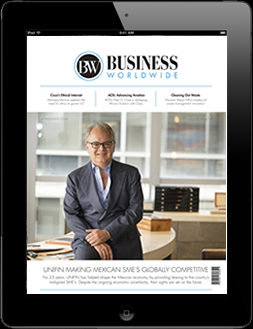With the rapid advances of technology, it is increasingly vital to focus on a guiding principle for successful innovation projects – what does the user genuinely need? gravity & storm are experts at devising innovative tailor made solutions for their clients.
After the pandemic forced changes to the way we leverage technology, organisations must now continually adapt when delivering digital solutions to truly serve their users.
Berlin based gravity & storm, a digital transformation agency led by award winning co-founder and CEO Naira Danielyan, have developed an effective recipe to unlock value by relentlessly focusing on creating a better experience for customers.
The topic of digital transformation is hardly a new one. However, as with all concepts, organisations need to embrace innovative ways of thinking and working in all parts of their business in order to achieve the improved results for their customers and themselves.
As with all things – saying it and doing it are very different and the stories of failed digital innovation projects, unloved digital products that crash and burn and IT strategies that financially cripple companies are legendary. In this high risk, high reward cauldron, there is a need for organisations to partner with passionate experts. Gravity & storm are a prime example of a successful innovation consultancy and digital agency boasting an impressive portfolio of global brands, including DHL, German Federal Ministry of Interior, Invia Travel, Sanofi, Takeda and Zeiss.
Born out of the world’s leading applied research institution, Fraunhofer-Gesellschaft, gravity & storm provides a range of services all based around the purpose of helping their clients achieve more with their digital ambitions. In practice this means the agency can design, develop and iterate on digital products from early stage prototypes used to validate an idea all the way through to full product development and launch.
Here co-founder and CEO of gravity & storm, Naira Danielyan tells us more about the innovative techniques adopted by the organisation and discusses future ambitions.
Naira, thank you so much for joining us. Let’s start with you setting the scene and telling us a bit about yourself and how you came to found gravity & storm.
My career journey within a range of organisations has always focused on innovation and strategic aspects as I’ve always held a deep curiosity to help solve challenges using innovative ways of thinking and working. I’m a firm believer in the practices of design thinking and the concept that innovation isn’t the responsibility of one specific team in a company, but is more a crucial cultural value that we should all embrace.
Some clients ask us about the name: who is gravity and who is storm. Well, sometimes we need to bring the storm of innovation when we are working with big clients and governmental institutions. In other cases when we work with start-ups with tons of ideas we need to bring gravity in by structuring the IT and building tangible roadmaps for product delivery.
Digital transformation and innovation mean different things to different people don’t they? What does it mean to you?
Those terms have been used so much that we’re at a point where we need to clarify that clients really do share the same definition as we do! Originally, digitalisation was all about the conversion of analogue information into digital formats. Even today we find people who limit their adoption of digital transformation to merely ensuring that everyone in the company uses a cloud based software programme or Slack for their team comms.
Gravity & storm believe that digital transformation is about solving problems worth solving. You can do amazing things with technology, but if you’re not genuinely focused on understanding your user and how to make things better for them, then you’re going to miss the mark. So, for us, it’s more about a digital mindset and developing specific behaviours within ourselves and the company to help us drive effective change.
That’s an interesting concept. What does that mean in practice?
Having a digital mindset means thinking in a proactive and entrepreneurial manner, being open to new technologies, focusing relentlessly on your customer and their needs and finally being able to embrace constructive criticism and use it as a way to learn.
Do you have a specific process that you follow to help projects stay on course?
Yes we do. We start with creating an idea for the product based on real user needs. This helps define the challenge we’re trying to solve as well as create an hypothesis for what we’ll be able to achieve. These elements are powerful guiding lights later in the project and act as reminders for decisions we make during the process.
Next we set up the project team which consists of our experts, domain experts and of course the clients stakeholders. It’s important to agree on the way we will be working as one team, who embodies which role and who is going to call the shots.
The team will then focus on understanding the user journey. Everything we do is user centric so we’ll use techniques such as research, interviews and observation to make sure we understand our user and their needs.
Once we’ve understood the hypotheses which needs testing we then move to stage four – which is a loop consisting of: ideation, prototyping and testing. This is an exciting stage where we can validate whether our initial thoughts on how to solve a user need are actually landing and in the right area.
From here we then look to create a minimal viable product – also known as an MVP – and once that has been through as many rounds of iteration as is needed, we move to the final stage – implementation!
To help bring this to life, can you share a relevant case study?
We’ve worked with a picture manufacturer who wanted to scale their business using an online shop. That sounds straightforward but there was a very intensive consultation process that was core to their service, and so understanding that and turning into a high quality digital version was a real challenge. We used a technique called a Design Sprint where we unpack the problem, create ideas for how to solve it and then actually prototype and test the digital solution all within four days.
This allowed us to make a huge amount of progress very rapidly and meant we could create an authentic and effective solution together with our client as a team.
That sounds fascinating. What does the future hold for gravity & storm?
More interesting work with interesting clients for sure, but beyond that we’ve launched three new services.
Firstly we’ve created a service called UX Lab that is focused on helping clients in those early product ideation, research and prototyping stages. Many of our clients have their own inhouse development teams but they struggle when it comes to the crucial early stages of an innovation project. UX Lab was created to help clients to understand their user needs, define solutions, build prototypes and test them.
There’s also our Go Digital stream where gravity & storm has been authorised by the Federal ministry of economics (BMWi) to help support and fund up to 50% of a small or medium sized company’s digital project.
Thirdly, we’ve launched a coaching and training service – workshops, seminars and one-to-one leadership programmes – where we provide sessions based on the latest innovation methods and customer-centric product development.
And of course you should always eat your own dogfood. So we are in the process of launching our very own tech product improving the efficiency for developing websites. So stay tuned!
In depth information on products and services offered by gravity & storm together with case studies and news on upcoming workshops, seminars and events can be found on the company website – gravity & storm (gravityandstorm.de)

















